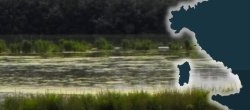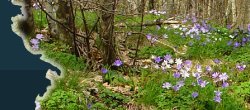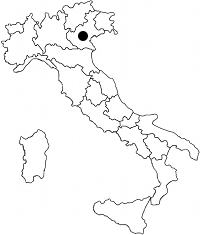

 |
Habitat Italia |  |
| home collaboratori documenti archivio link tematici |
|
mostra didascalie (in ogni campo)
11: Acque marine e ambienti a marea1180: Strutture sottomarine causate da emissioni di gas
Codice CORINE BiotopesCodice EUNISTipi rilevanti sotto A5.71 Seeps and vents in sublittoral sediments
Regione biogeografica di appartenenzaMediterranea Marina
Descrizione generale dell’habitat Submarine structures consist of sandstone slabs, pavements, and pillars up to 4 m high, formed by aggregation of carbonate cement resulting from microbial oxidation of gas emissions, mainly methane. The formations are interspersed with gas vents that intermittently release gas. The methane most likely originates from the microbial decomposition of fossil plant materials.
The first type of submarine structures is known as “bubbling reefs”. These formations support a zonation of diverse benthic communities consisting of algae and/or invertebrate specialists of hard marine substrates different to that of the surrounding habitat. Animals seeking shelter in the numerous caves further enhance the biodiversity. A variety of sublittoral topographic features is included in this habitat, such as overhangs, vertical pillars and stratified leaf-like structures with numerous caves.
The second type are carbonate structures within “pockmarks”. “Pockmarks” are depressions in soft sediment seabed areas, up to 45 m deep and a few hundred meters wide. Not all pockmarks are formed by leaking gases and of those formed by leaking gases, many do not contain substantial carbonate structures and are therefore not included in this habitat. Benthic communities consist of invertebrate specialists of hard marine substrata and are different from the surrounding (usually) muddy habitat. The diversity of the infauna community in the muddy slope surrounding the “pockmark” may also be high. Frase diagnostica dell’habitat in ItaliaStrutture sottomarine costituite da fondo duro originato dalla cementificazione di materiale sedimentario attraverso processi di ossidazione microbica in presenza di emissioni di gas metano.
Sottotipi e varianti (compilare se necessario)Questo habitat si può presentare sotto due forme:
• “Scogliere che emettono bolle di gas” o “bubbling reefs”, ovvero scogliere associate ad emissioni di gas, talvolta intermittenti, e formate da lastre di roccia, pilastri verticali e strutture stratificate ricche di anfratti (Taviani, 2014), coperte da formazioni biogeniche. Su queste scogliere si sviluppano, secondo gradienti, diverse comunità bentoniche algali o animali proprie dei fondi duri, che possono dare vita a formazioni biogeniche (ad esempio in Alto Adriatico) (Tosi et al., 2017).
• “Pockmark”, ovvero strutture di natura carbonatica all’interno di depressioni dei fondali mobili marini, profonde fino a 45 metri e larghe anche qualche centinaio di metri (alcune sono state localizzate oltre le acque territoriali antistanti la Calabria tirrenica e la Sicilia meridionale). Dette strutture carbonatiche ospitano una fauna di invertebrati bentonici tipica dei substrati duri, molto differente da quella presente sui fondi mobili circostanti (Savini et al., 2009; Taviani, 2014; Taviani et al., 2013, 2015; Franchi et al., 2017). A tali strutture è associata una diversificata comunità di organismi chemio-simbionti. Combinazione fisionomica di riferimentoSe le strutture sono situate nella zona fotica, sono generalmente colonizzate da alghe corallinacee.
Riferimento sintassonomicoDinamiche e contattiLe “strutture sottomarine causate da emissioni gassose” possono essere trovate in associazione con gli habitat “Scogliere” (1170) e “Banchi di sabbia a debole copertura permanente di acqua marina” (1110). Si segnala che l’associazione a questo ultimo tipo di habitat non è stata segnalata nelle acque italiane.
Specie alloctoneSpecie animali importanti“Scogliere che emettono bolle di gas”
Grande diversità di invertebrati come Poriferi, Antozoi, Policheti, Gasteropodi, Decapodi, Echinodermi; sono presenti inoltre numerose specie di pesci. “Pockmark” Si tratta di strutture che, proprio per la loro natura, ospitano una ricca comunità bentonica e sono caratterizzate da una biodiversità generalmente elevata e dalla presenza di invertebrati chemio-simbionti, tipici di fondo duro. Le specie dominanti in termini di abbondanza e biomassa sono Policheti Vestimentiferi, in particolare del genere Lamellibrachia, e Molluschi, sia bivalvi, delle famiglie Vesicomydae (Isorropodon perplexum), Lucinidae (Lucinoma kazani, Myrtea amorpha) e Thyasiridae (Thyasira sp.), che gasteropodi (Taranis moerchii). Nei sedimenti campionati sono stati ritrovati numerosi esemplari, sia vivi che morti, di crostacei decapodi Callaniassidi (Calliax sp.).
Nei sedimenti che circondano i pockmark sono inoltre presenti Nematodi, Policheti serpulidi, molluschi pelagici ed echinoidei.
Su sedimenti di natura carbonatica sono presenti anche briozoi del genere Reteporella. Distribuzione dell’habitat in Italia
Veneto
● Dato già presente in BD Natura 2000 e confermato NoteRiferimenti BibliograficiDANDO P.R., AUSTEN M.C., BURKE R.A. JR, KENDALL M.A., KENNICUTT M.C. II, JUDD A.G., MOORE D.C., O'HARA S.C.M., SCHMALJOHANN R., SOUTHWARD A.J., 1991. Ecology of a North Sea Pockmark with an active methane seep. Mar.Ecol. Prog. Ser., 70: 49-63.
FRANCHI F., ROVERE M., GAMBERI F., RASHED H., VASELLI O., TASSI F., 2017. Authigenic minerals from the Paola Ridge (southern Tyrrhenian Sea): evidences of episodic methane seepage. Mar. Petrol. Geol., 86: 228-247.
HANSEN J.M., 1988. Koraller i Kattegat, kortlægning. Miljøministeriets, Skov- og Naturstyrelsen.
HOVLAND M., JUDD A.G., 1988. Seabed pockmarks and seepages: impact on geology, biology and the marine environment. Graham & Trotman, London. 245pp.
JENSEN P., AAGAARD I., BURKE R.A. JR, DANDO P.R., JORGENSEN N.O., KUIJPERS A., LAIER T., O'HARA S.C.M., SCHMALJOHANN R., 1992. “Bubbling reefs” in the Kattegat: submarine landscapes of carbonate cemented rocks support a diverse ecosystem at methane seeps. Mar. Ecol. Prog. Ser., 83:103-112.
JOHNSTON C.J., TURNBULL C.G., TASKER M.L., 2002. Natura 2000 in UK Offshore Waters: Advice to support the implementation of the EC Habitats and Birds Directives in UK offshores waters. JNCC Report 325.
JØRGENSEN N.O., 1989. Holocene methane-derived dolomite-cemented sandstone pillars from Kattegat, Denmark. Mar. Geol., 88: 71-81.
JØRGENSEN N.O., LAIER T., BUCHARDT B., CEDERBERG T., 1990. Shallow hydrocarbon gas in the northern Jutland-Kattegat region, Denmark. Bull. Geol. Soc., 38: 69-76.
LAIER T., LOMHOLT S., KUIJPERS A., 1991. Carbonate-pillars and gas seepages in Kattegat: Seismic mapping of an area NW of Hirsholmene Islands. Geol. Survey Denmark, Report No. 13, 31 pp.
SAVINI A., MALINVERNO E., ETIOPE G., TESSAROLO C., CORSELLI C., 2009. Shallow seep-related seafloor features along the Malta plateau (Sicily channel–Mediterranean Sea): morphologies and geo-environmental control of their distribution. Mar. Petrol. Geol., 26: 1831-1848.
TAVIANI M., 2014. Marine chemosynthesis in the Mediterranean Sea. In: Goffredo S., Dubinsky Z. (eds.). The Mediterranean Sea: its history and present challenges. Springer Netherlands. pp. 69-83.
TAVIANI M., ANGELETTI L., CEREGATO A., FOGLINI F., FROGLIA C., TRINCARDI F., 2013. The Gela Basin pockmark field in the strait of Sicily (Mediterranean Sea): chemosymbiotic faunal and carbonate signatures of postglacial to modern cold seepage. Biogeosciences 10: 4653-4671.
TAVIANI M., FRANCHI F., ANGELETTI L., CORREGGIARI A., CORREA M.L., MASELLI V., MAZZOLI C., PECKMANN J., 2015. Biodetrital carbonates on the Adriatic continental shelf imprinted by oxidation of seeping hydrocarbons. Mar. Petrol. Geol., 66: 511-531.
TOSI L., ZECCHIN M., FRANCHI F., BERGAMASCO A., DA LIO C., BARADELLO L., MAZZOLI C., MONTAGNA P., TAVIANI M., TAGLIAPIETRA D., CAROL E., FRANCESCHINI G., GIOVANARDI O., DONNICI S., 2017. Paleochannel and beach-bar palimpsest topography as initial substrate for coralligenous buildups offshore Venice, Italy. Sci. Rep., 7: 1321. doi:10.1038/s41598-017-01483-z. Riferimenti Bibliografici onlineNomi dei compilatori con e.mailSimonepietro Canese (simonepietro.canese@szn.it), Leonardo Tunesi (leonardo.tunesi@isprambiente.it)
|